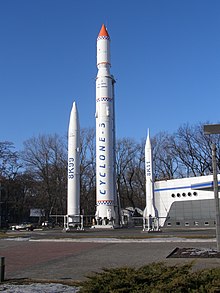R-11 Zemlya


The R-11 Zemlya (
Scud
. Variant R-11M was accepted into service, with GRAU index 9K51 (9К51).
Origin
The R-11 originated from a 1951 requirement for a
GRAU index 9K51, the rocket itself 8K11, and the launcher 8U218.[3]
Systems specification
Like the V-2, the R-11 relied on
HE-Frag warhead 9N33 with 535 kg (1,179 lb) of explosive.[3]

A naval variant, the R-11FM was first tested at
Project 629 (Golf Class) submarines, until its replacement by the R-13 in 1961 (SS-N-4) and the R-21 (SS-N-5) in 1963.[7] During its service, 77 launches were conducted, of which 59 were successful.[8]
The success of the R-11FM established Makeev as the main designer of submarine-launched weapons for the Soviet Armed Forces, and the R-11FM served with the first generation SLBM submarine units of the Soviet Navy.
See also
References
- ^ Johnston's Archive – Soviet/Russian Missile Designations
- ^ a b c Wade, Mark. "R-11". Encyclopedia Astronautica. Archived from the original on March 9, 2002. Retrieved 2008-02-17.
- ^ ISSN 1895-3344
- ^ Zaloga, p.4
- ^ "Rocket R-11". RSC "Energia". Retrieved 2021-01-01.
- ^ Zaloga, p.8
- Jane's Information Group. 26 April 2001. Archived from the originalon 2007-12-15. Retrieved 2008-02-12.
- ^ "R-11FM / SS-1b Scud". Federation of American Scientists. July 13, 2000. Retrieved 2008-02-19.
External links
- Ballistic Missile Reference from the Federation of American Scientists
- Missile Threat: A Project of the George C. Marshall Institute
- R-11 / SS-1B SCUD-A

